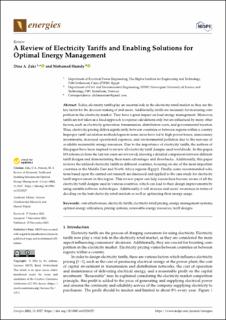| dc.description.abstract | oday, electricity tariffs play an essential role in the electricity retail market as they are the key factor for the decision-making of end-users. Additionally, tariffs are necessary for increasing competition in the electricity market. They have a great impact on load energy management. Moreover, tariffs are not taken as a fixed approach to expense calculations only but are influenced by many other factors, such as electricity generation, transmission, distribution costs, and governmental taxation. Thus, electricity pricing differs significantly between countries or between regions within a country. Improper tariff calculation methodologies in some areas have led to high-power losses, unnecessary investments, increased operational expenses, and environmental pollution due to the non-use of available sustainable energy resources. Due to the importance of electricity tariffs, the authors of this paper have been inspired to review all electricity tariff designs used worldwide. In this paper, 103 references from the last ten years are reviewed, showing a detailed comparison between different tariff designs and demonstrating their main advantages and drawbacks. Additionally, this paper reviews the utilized electricity tariffs in different countries, focusing on one of the most important countries in the Middle East and North Africa regions (Egypt). Finally, some recommended solutions based upon the carried-out research are discussed and applied to the case study for electricity tariff improvement in this region. This review paper can help researchers become aware of all the electricity tariff designs used in various countries, which can lead to their design improvements by using suitable software technologies. Additionally, it will increase end-users’ awareness in terms of deciding on the best electricity retail markets as well as optimizing their energy usage. | en_US |

